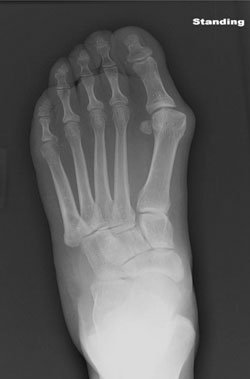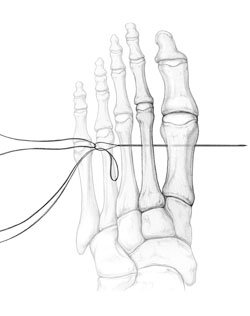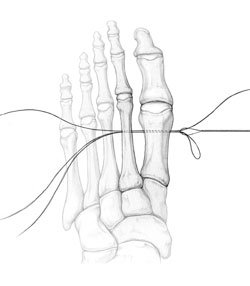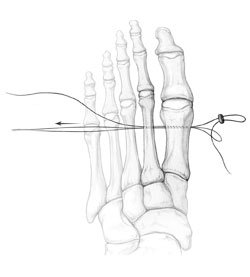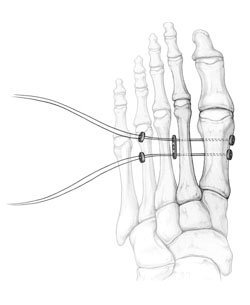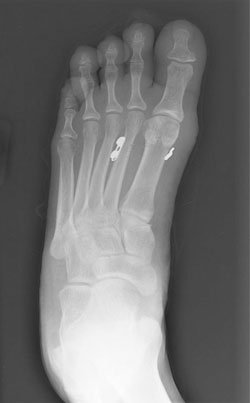Correction of hallux valgus without osteotomy allows for faster recovery
The intermetatarsal angle component of the hallux valgus deformity can be corrected by threading a small suture-wire between the first and second metatarsals, which is then anchored to both sides and tightened to realign the bone. This technique corrects the intermetatarsal angle without the need for a first metatarsal osteotomy, which enhances postoperative recovery and mobilization.
The indications for this procedure include bunion deformities with an intermetatarsal angle (IMA) greater than 8° to 9° but less than 20°. The hallux valgus angle (HVA) should be no greater than about 30°. The distal metatarsal articular angle (DMAA) should be less than 10° (Figure 1). The presence of mild-to-moderate joint incongruity is not a contraindication. In the presence of an interphalangeus deformity, this technique can be used in conjunction with an Akin osteotomy of the proximal phalanx.
Contraindications for this technique include patients with diabetes mellitus as well as systemic immune-based arthropathies such as rheumatoid arthritis, gout, psoriatic arthritis and lupus. Patients with a stiff foot, a significant lateral facet of the proximal first metatarsal, hypermobility of the metatarsocuneiform joint or arthritis of the metatarsocuneiform or metatarsophalangeal (MTP) joints would not be candidates for this procedure. In terms of angular measurements, patients with HVAs greater than about 30°, IMAs greater than 20° or DMAAs greater than 10° would also not be appropriate for this procedure.
Release of the adductor tendon, lateral capsule and sesamoids
|
Images: Holmes GB |
The use of FiberWire-attached endobuttons via a 1.1-mm drill hole (Mini TightRope, Arthrex) relies on the utilization of the soft tissue procedures popularized by McBride and Mann. The first part of this procedure requires the release of the adductor tendon from its attachment to the base of the proximal phalanx of the first MTP joint and from the lateral (fibular) sesamoid. This is followed by release of the first web space intermetatarsal ligament, release of the lateral capsule of the first MTP joint, and preparation for binding of the now-released adductor to the respective capsules of the first and second MTP joints.
Adhering to the soft tissue principles of McBride and Mann, I make a longitudinal incision distally between the first and second metatarsals. By blunt and sharp dissection the adductor tendon is identified as it attaches to the lateral aspect of the proximal phalanx of the great toe. This can be a quite distinguishable structure or it can blend into the lateral capsule. Mild abduction and adduction of the great toe can assist in detecting the borders of this tendon. The tendon is grasped with a forceps as the attachment is released with a No. 15 blade. As this dissection is continued proximally the adductor is released from its attachment to the fibular sesamoid.
You should now be able to clearly visualize the intermetatarsal ligament. I then place a Freer elevator beneath the ligament and use a No. 15 blade to transect the ligament, avoiding injury to the underlying neurovascular bundle. It is important to identify the interdigital nerve and adjacent vein at the completion of the transection of the ligament. A No. 11 blade is now oriented perpendicular to the long axis of the first metatarsal to perforate the lateral capsule at the level of the joint line. A varus stress is applied to the great toe to tear or release the contracted lateral capsule.
A Freer elevator or small key elevator is used to assure that the fibular sesamoid is mobile and can be reduced beneath the first metatarsal head.
Assessment for IMA reducibility
At this juncture it is important to determine the ease of reducibility of the IMA. With two finger medial and lateral compression across the distal metatarsals, you should be able to easily approximate the distal aspects of the first and second metatarsals. The intermetatarsal space should be easily obliterated with this maneuver. If the space cannot be easily reduced, an alternative technique such as an osteotomy or Lapidus procedure should complete the correction of the deformity.
Using a small diameter Mayo needle, at least three nonabsorbable 2-0 vicryl sutures are placed to incorporate the medial capsule of the second MTP joint, the adductor tendon and the lateral capsule of the first MTP joint. Each of the sutures is secured with a hemostat to be tied later in the procedure. It is important to incorporate the capsules proximal to the joint line.
Medial exostectomy
You should now address the medial aspect of the first MTP joint. With a skin marker outline the dorsal and plantar digital nerves over the first MTP joint. The skin incision is drawn between these two parallel lines.
The second part of the procedure includes excision of the medial exostosis. The initial incision is made just through the skin avoiding penetrating the underlying capsule. The skin margins are retracted with two- or four-prong small skin hooks as the dorsal and plantar flaps are developed using a No. 15 blade. The capsule should be exposed enough to palpate the joint extending proximally to the metaphyseal-diaphyseal junction and distally to the base of the proximal phalanx. I use the capsular incision popularized by Mann. A No. 11 blade is used to excise a 3- to 4-mm wedge of the capsule perpendicular to the longitudinal orientation of the incision. A proximally directed dorsal longitudinal incision is used to facilitate exposure of the entire medial eminence.
I prefer to remove the medial eminence with an osteotome oriented in a distal-to-proximal direction just medial to the sulcus. This placement will avoid an overly aggressive resection of the medial eminence. Such an excessive resection can lead to a loss of the metatarsal medial buttress and thereby possibly result in a varus deformity.
Preparation and insertion
Following resection of the medial eminence a key elevator is used to expose the medial aspect of the first metatarsal proximal to the metaphyseal-diaphyseal junction. It may be necessary to extend the incision proximally to achieve an adequate exposure.
A guide pin, K-wire or Freer elevator is now positioned over the dorsum of the foot to approximate the line of placement of the endobutton-attached FiberWire construction. Using an intraoperative imager, a line is selected such that the medial aspect of the transverse line of the distal-most endobutton will be just proximal to the metaphyseal-diaphyseal junction of the first metatarsal and the lateral button on the second metatarsal will be at least 2 mm to 3 mm proximal to the neck of the second metatarsal. Once finalized, this line can be drawn on the skin with a marking scribe.
A small key elevator is used to adequately expose the second metatarsal to allow placement of a Homan retractor around the lateral aspect of the second metatarsal. The periosteal elevator is used to expose an adjacent area of the lateral aspect of the first metatarsal in line with the transverse line previously drawn on the skin.
Advancing the guide wire
|
|
With a power drill, the 1.1-mm guide wire is inserted through the mid-portion (between the dorsal and plantar aspect) of the second metatarsal aiming towards the confluence of the metaphyseal-diaphyseal junction of the first metatarsal. Since the dorsal plantar height of the first metatarsal is significantly greater than that of the second metatarsal, the acceptable range for exiting the medial aspect of the first metatarsal is greater than if the first metatarsal were the starting point.
The 1.1-mm guide wire is advanced until the smaller taper portion completely crosses the medial border of the first metatarsal. One strand of the suture-wire from the deconstructed button is passed through the loop at the end of the 1.1-mm guide wire (Figure 2). A loop of 4.0 nylon suture is separately passed through the loop at the end of the 1.1-mm guide wire. The two free ends of the 4-0 nylon loop are clamped together with a small hemostat. The 1.1-mm guide wire is then manually pulled through the first metatarsal in a medial direction using a hemostat or needle holder. This pulls both the single strand of the suture-wire and the loop of the 4-0 nylon suture to the medial side of the first metatarsal (Figure 3A). The two ends of the loop of the 4.0 nylon clamped with the hemostat remain on the lateral aspect of the second metatarsal.
Both the loop of the 4-0 nylon and the single strand of the suture-wire are removed from the loop end of the 1.1-mm guide wire. The suture-wire is now passed through the two holes of the oblong button. The end of the suture-wire on the medial side of the first metatarsal is now passed back through the loop of the 4-0 nylon. The loop of the 4-0 nylon with the strand of the suture-wire are then pulled back through the drill hole using the hemostat attached to the ends of the 4-0 nylon on the lateral side of the second metatarsal (Figure 3B). This results in the placement of the oblong button on the medial side of the first metatarsal and the two free ends of the suture-wire on the lateral side of the second metatarsal.
|
|
|
An alternative method
In an alternative method, place the first 1.1-mm guide wire in the usual fashion from the second to the first metatarsal. Then place the second 1.1-mm guide wire from a medial (first metatarsal) to a lateral (second metatarsal) parallel and adjacent to the first guide wire. Using the loop at the end of the 1.1-guide wire, pull a single strand of suture-wire from the lateral side of the second metatarsal to the medial side of the first metatarsal. After placing the end through the oblong button, the suture-wire is pulled back across the first to second metatarsal using the second 1.1-mm guide wire.
The placement site of the second more proximal 1.1-mm endobutton construction is determined by using the buttress plate as the template. The distal hole of the plate is aligned with the distal two suture-wire free ends that were previously pulled through the second metatarsal. The second, proximal drilling point is selected to correspond with the proximal hole of the plate. A scribe pen or Bovie is used to mark the location on the lateral border of the second metatarsal. The same procedure (or alternative procedure) is now repeated for drilling the 1.1-mm guide wire and passage of the suture-wire.
Following the passage of the second suture-wire with the medially attached oblong button, both the distal and proximal suture-wires are passed through the distal and proximal holes of the buttress plate, respectively. The sutures are then each passed through a distal and a proximal round button (Figure 4).
|
|
The aforementioned technique is described for the insertion of two 1.1-mm endobutton suture-wire constructs, but can also — at the surgeon’s discretion — be used for a single 1.1-mm endobutton suture-wire using the central hole on the lateral buttress plate.
Reduction of the IMA
The IMA is now reduced manually. This reduction is maintained while the endobutton and suture-wire construct (the medial oblong button, the second metatarsal lateral buttress plate and the lateral round button) is tightened and tied into position. The reduction can be maintained by the manual compression of an assistant, a K-wire between the first and second metatarsals, or a large towel clamp.
Following the placement of one or two throws in the knot on the lateral side of the second metatarsal, an intraoperative image of the reduction is obtained to confirm the following:
- the lack of soft tissue interposition between the buttons/plate and the bone,
- reduction of the intermetatarsal angle, and
- reduction of the sesamoids (Figure 5).
|
|
If I determine that the sesamoids are not adequately reduced but can be reduced with a slight upward pull on the plantar capsule on medial aspect of the first metatarsal, I will then tie five firm knots in each suture-wire–endobutton assembly. The suture-wire is cut with a knife leaving a tail of sufficient length so that I can tuck the tail plantarward around the lateral border of the second metatarsal. If the tail is too short it may result in irritation beneath the skin in the interspace between the second and third metatarsals. The previously passed 2-0 vicryl sutures in the first intermetatarsal space are now individually tied to create a soft tissue repair between the metatarsal heads.
Medial capsular repair
You may choose any one of a number of techniques to approximate/plicate the medial capsule. The medial capsular closure should achieve the goal of maintaining the correction of the HVA at the first MTP joint as well as securing the correct positioning of the sesamoids beneath the first metatarsal head.
This later goal will require bringing up the plantar flap in dorsal orientation to the metatarsal. It is helpful to have your assistant hold the great toe in such a manner as to derotate the pronation deformity and maintain correction of the hallux valgus angulation. It is also helpful to keep the interphalangeal joint in extension while the pronation deformity is being held in the corrected position. This will assist in reducing the sesamoids. The final correction is demonstrated in Figure 5.
The dorsal first intermetatarsal incision is closed in two layers using an interrupted 3-0 plain/catgut suture for the subcutaneous and an interrupted, nonabsorbable, non-braided 3-0 nylon for the skin.
Postoperative dressing, aftercare
I apply one layer of Adaptic (Johnson & Johnson) over the incision sites. This is followed by the application of 4×4 sponges on the dorsal and plantar aspects of the foot with some overlap over the medial and lateral aspects of the foot. A 4-in Kling bandage (Johnson & Johnson) is applied snuggly around the foot over the 4×4 sponges. This is followed by a 4-in elastic bandage with one turn of the bandage around the ankle to prevent slippage. This dressing is left intact for 3 to 5 days after the procedure.
Patients are kept nonweight-bearing in a postoperative shoe for 2 weeks postoperatively. For the next 4 weeks, they are allowed to bear weight in a postoperative shoe or short cam boot. During this 6-week period, they undergo weekly dressing changes using a compression dressing of a Kling bandage to maintain the soft tissue correction of the HVA deformity. After 6 weeks the dressing is removed and the patient will use a toe spacer between the first and second toes. The patient is also allowed to wear a comfortable, thick-soled shoe for the next month. Finally they are allowed to wear comfortable shoes as determined by the resolution of any residual swelling.

- George B. Holmes Jr., MD, can be reached at 1611 W. Harrison St., Ste 300, Chicago, IL 60612; 312-432-2563; e-mail: gholmes@rushortho.com.
Disclosure: Holmes is the inventor of this technique and has a royalty and consulting agreement with Arthrex, the manufacturer of this system. He holds no stock in the company, nor does he hold any titles or offices within the company.

